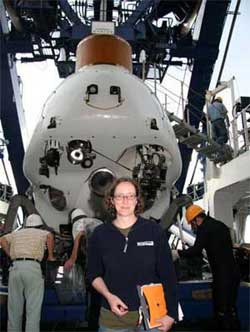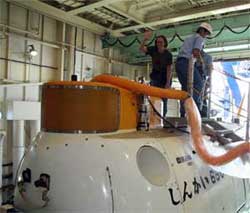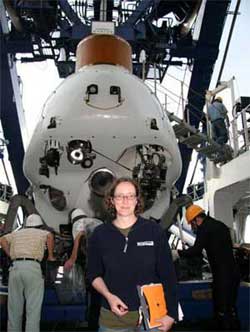 She travels 3 miles deep to study how continents form
She travels 3 miles deep to study how continents form
NARRAGANSETT, R.I. – July 31, 2007 — When University of Rhode Island oceanographer Katherine Kelley climbed into a submersible vehicle for the first time last September, she felt considerable anxiety and worried that she would be claustrophobic.
With good reason. She was about to travel three miles below the surface of the Pacific Ocean to the southern end of the Mariana Trench near Guam, one of the deepest places in any ocean on Earth. She was crammed alongside two pilots in a two-meter sphere within the Shinkai 6500, a mini submarine that would not be tethered to the Japanese research vessel R/V Yokosuka, from which they departed at the surface.
It was her first time in a submersible – although given her career choice, it will not be her last – and as they descended, she was somewhat surprised at how quickly it got dark (within 200 meters of the surface) and how quickly it got cold in the vehicle.
“The Japanese pilots did a great job of putting me at ease during the two-and-a-half hour trip to the bottom,” said Kelley, a URI assistant research professor. “They practiced their English language skills with me, and we listened to Japanese pop music. Once we got to the bottom, I was very focused on my scientific procedures, so I forgot about my concerns.”
 Kelley’s trip to the seafloor thousands of miles from home was designed to help her gain a better understanding of how continents are built by studying the rocks ejected from the Earth’s mantle when tectonic plates collide and create underwater volcanoes. She said the Mariana Trench is an excellent place for studying plate tectonics because it is in a subduction zone – the place where two plates collide and one is forced beneath the other.
Kelley’s trip to the seafloor thousands of miles from home was designed to help her gain a better understanding of how continents are built by studying the rocks ejected from the Earth’s mantle when tectonic plates collide and create underwater volcanoes. She said the Mariana Trench is an excellent place for studying plate tectonics because it is in a subduction zone – the place where two plates collide and one is forced beneath the other.
“When one plate moves downward, it goes into the Earth’s mantle with a cargo of oceanic crust laden with sediments and water,” she explained. “The water is later released into the solid mantle where it causes melting, which creates magma and volcanoes at the surface. You end up with a chain of volcanic islands.”
Kelley’s expedition in the submersible was aimed at finding rocks from the earliest stages of the subduction, approximately 40 million years ago.
“When we got to the bottom, it was very dark so we couldn’t see very far, but I was riveted to the six-inch porthole,” said Kelley, who lives in Wakefield but grew up in Mankato, Minn., and earned her Ph.D. from Boston University in 2004. “I just couldn’t keep me eyes off it, even though video cameras outside the vehicle were broadcasting images to monitors inside.”
Her eight-hour trip in the submersible traversed 1.5 kilometers along a steep ravine looking for large rocks under the sediment. During the course of the nine-day expedition, Kelley and her colleagues collected numerous rock samples that represented a “complete crustal sequence” – rocks from every layer of the Earth’s crust.
In the 10 months since she returned to URI from the research expedition, Kelley has been analyzing the rocks using a state-of-the-art laser ablation system at URI’s Graduate School of Oceanography to determine their composition.
“We definitely found some boninite, a rock type that has high silica and magnesium content and is almost exclusively identified with the very early stages of subduction,” Kelley explained. “I was very excited to find boninite. We also found basalt, which has a lower silica content and is the rock type that composes most of the rest of the Earth’s oceanic crust.”
As she continues to analyze the rock samples from last year’s cruise, she is planning a follow-up expedition in the summer of 2008 to the Santa Rosa Bank, another area of the subduction zone in the Mariana Trench.
She also recently received a National Science Foundation grant that will find her studying rocks from a very different geologic setting – a mid-ocean ridge where tectonic plates are separating instead of colliding – to compare how the mantle melting process there differs from that which occurs in the subduction zone. That project is now in its early stages.
URI Assistant Research Professor Katherine Kelley prepares to enter a submersible vehicle to explore the ocean floor.

